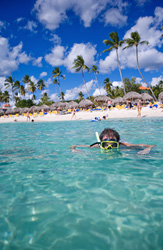Which U.S. Beaches Have the Most Shark Attacks?
Plus Essential Beach Safety Tips
by www.SixWise.com
On your next summer vacation to certain beaches of Florida, Hawaii and California you may be swimming with a sea of sharks and not even know it.
|

Many shark attacks occur when a shark mistakes your splashing arms and legs for a wounded animal.
|
Most shark attacks happen in surf zones and in most cases it’s the shark confusing your hands splashing and legs kicking for a wounded animal. Though this may sound scary, shark attacks are rare and are usually exaggerated and dwelled upon when they do happen -- often even stifling the work of shark researchers.
According to Laleh Mohajerani, executive director of the shark conservation organization Lemanya Oceanica in a Forbes Traveler article, sharks are not looking to interfere with humans in the water. She continues:
“Our shark attack fears are irrational. You are more likely to be hit by lightening.”
7 Top Shark-Inhabited Beaches
In the United States, you may be slightly more likely to encounter a shark if you frequent one of these seven beaches:
-
The beach that gave inspiration for the book “Jaws,” written by Peter Benchley, followed by the chilling movie by Steven Spielberg. They were based on actual shark attacks that took place in 1916 in which within 11 days, five major shark attacks occurred, killing four people. Sharks are now a rare sighting on these beaches, but the legend lives on in American pop culture.
What to Do if You’re Attacked by a Shark
Most shark attacks are caused by sharks mistaking flailing human body parts for seals or other animals. And although the threat of a shark attack is rare, it does occur, so it is best to know what to do if you are bitten or how to go about helping someone being attacked.
First Avoid Becoming a Victim of a Shark Attack
-
Always swim, surf or dive with a group of people as sharks usually attack individuals.
-
Avoid swimming while it is dark outside or approaching twilight hours. These are the times sharks are most active and more likely to venture closer to the shore to feed.
-
If you are bleeding from an open cut or menstruating, do not go in the water. Sharks have an incredible olfactory ability and can smell and trace the smallest amount of blood from 1.6 kilometers away.
-
Leave any shiny jewelry and brightly colored clothing at the hotel. Sharks have a keen ability to see contrast and reflecting light from metals may be mistaken for fish scales.
-
Avoid waters containing shark bait such as sewage waters used by commercial fisherman and fishing boats that often have remains of fish and blood around them.
-
Porpoises don’t mean that sharks aren’t far off, as they are attracted to the same food as sharks.
-
Swim clear of seals and sea lions as they are a primary food source for sharks.
-
Save the splashing for pools. Erratic movements and activity are a surefire way to attract shark attention.
-
Avoid sandbars, drop-offs and harbor entrances. These are frequented and favorite areas for sharks.
-
Do not go in waters that have been known to have a heavy shark presence.
-
If you spot a shark get out of the water as calmly and quickly as possible. If you are diving and a shark swims near you, stay as still as possible then quietly leave the area.
If You Are Attacked, Here’s How to Defend Yourself …
-
Use whatever weapons you can, targeting the sensitive parts of the shark such as the eyes, snout and gill openings.
-
If a shark wraps his mouth around you and takes hold, you should fight aggressively and defensively by pounding on the shark wherever you can. Playing dead is ineffective in this type of situation.
-
If you are bit, do what you can to try to stop the bleeding. Get out of the water as quietly and quickly as possible.
-
Seek medical attention for the injury no matter the size.
How to Help Someone Who has Been Attacked
-
Get them to the shore as quickly as possible.
-
While assisting them out of the water, begin immediately applying pressure using a tourniquet to the pressure points to control the bleeding.
-
Try to prevent the victim from going into shock by wrapping them in a blanket.
-
After getting them out of the water, try not to move them unnecessarily and call for medical help immediately.
Other Dangerous Creatures of the Sea
Other dangers lurk beneath the ocean surface that can result in a trip to the emergency room as well. Knowledge is power and learning about these dangers before your next swim could lessen the likelihood of injury.
The Dangerous Tail
Stingrays carry a poisonous barb on their tails, containing a toxic mucus and when they sting something the toxin travels into the wound resulting in swelling and stinging sensation.
If you are stung, you should try to get the stung body part into water as hot as you can stand (104 to 105 degrees) to get rid of the toxin.
Short Tentacle Sting
Jellyfish can sting only if direct contact with the swimmer has been made due to the pressure sensitivity of the stinging cells. If you are stung, the best thing to do is to gently extract the tentacle and apply white vinegar to the infected area to break down the toxin. This will also relieve the pain and swelling.
Long Tentacle Hazard
Similar to jellyfish, the Portuguese Man-of-War has tentacles that can grow up to 165 feet long that can stretch out to great distances, making them hard to be seen and easy to step on. Stings are best treated with hot water. One of the best protection devices against these creatures are rash guards.
Blooming Plant-Like Poisons
Phytoplanktons are found in most coastal areas and when in bloom can produce billions and billions of microscopic plantlike organisms in the water that release poisonous toxins. The best treatment is to apply Benadryl to reduce the effects of the allergic reaction.
|

Stay Hydrated While in the Sun!Your Beach-Time Buddy: 100% Natural, Caffeine-Free CoCo Energy
Delicious CoCo Energy keeps you hydrated, and is 100% NATURAL with No Preservatives and No Artificial Flavors or Colors. Slip the powdered packets into your beach bag or purse, add to any bottle of water and get ready to be refreshed!
-
Coconut water is more nutritious than whole milk -- less fat and NO cholesterol, and lower in calories than orange juice.
-
Coconut water is a Natural Isotonic Beverage -- it has the same level we have in our blood, thus does not have an adverse affect on blood sugar or pressure.
-
Coconut water contains more potassium (at about 294 mg) than most sports drinks (117 mg) and most energy drinks.
-
Coconut water has less sodium (25mg) whereas sports drinks have around 41mg and energy drinks have about 200 mg!
Buy any 4 products and receive $5 shipping, buy any 6 and receive FREE SHIPPING!
Learn More and Order CoCo Energy Now!

|
Common Summer Dangers at the Beach
There are other more common summer dangers on the beach to be aware of that revolve around the heat and general swimming safety. Of course, in most cases a trip to the beach is a relaxing and enjoyable way to spend your summer, but by gaining knowledge now you can reduce your risk of falling victim to these summer hazards.
Heat Stroke
Lying out on the beach, playing sand volleyball or taking part in other beach activities require exertion and exposure to the sun and risk of heat stroke. The key to preventing heat stroke is staying well hydrated by drinking water or a natural energy drink that contains electrolytes to help replenish salt and retain fluid.
One of our favorites is CoCo Energy, made with coconut water, which is a Natural Isotonic Beverage -- it has the same level we have in our blood, thus does not have an adverse affect on blood sugar or pressure.
Coconut water contains more potassium (at about 294 mg) than most sports drinks (117 mg) and most energy drinks. It also has less sodium (25mg) whereas sports drinks have around 41mg and energy drinks have about 200 mg!
Remember when you’ll be outdoors in warm weather that it is important to be familiar with heat stroke warning signs:
-
Red, hot dry skin
-
Rapid pulse
-
Throbbing headache
-
Confusion
-
Dizziness
-
Leg Cramps
-
Nausea
If you begin to experience any of these symptoms, it is critical that you address them immediately by taking steps to cool your body temperature down. You can do this by applying ice packs to the groin, armpits and neck, placing the person in a cool shower or wrapping a cool wet blanket around them.
Drowning Dangers and Rip Tides
According to the Centers for Disease Control and Prevention, 800 children die each year as the result of drowning. It is also the number one cause of injury in children ages 1 to 3.
Anytime there is water and kids there is the danger of drowning, which happens quickly and silently. The number one cause of kids drowning is lack of adult supervision. For this reason, children need constant supervision around water.
5 Tips to Prevent a Drowning Tragedy
-
Remain within arm’s reach of your child.
-
Be selective with your swimming areas -- Look for well-maintained beaches that have a lifeguard on duty and stay in the designated swim areas.
-
Use proper safety devices -- If your child is playing any kind of water sports or is near open bodies of water they need to be wearing a U.S. Coast Guard-approved life preserver. Arm floaties aren’t approved for safety and won’t protect your child from drowning.
-
Don’t depend on the lifeguard for your child’s safety -- It’s a great assurance to have a lifeguard on duty, but ultimately it is your responsibility to keep an eagle-eye watch on your children.
-
Keep a close eye when using inflatable pools -- Be sure to drain them completely after using them and watch your child closely even in very shallow water.
For adults and even the strongest of swimmers, rip currents can pose a great and sometimes deadly danger. Rip currents are defined as narrow, fast-moving belts of water traveling offshore that can travel in speeds up to 1-2 feet per second. They are the causes of over 100 drowning deaths each year in the United States. Some of the tell-tale signs of rip current formations include:
-
Churning and choppy water
-
Area of water with a noticeable difference in color
-
Foam, seaweed or debris moving at a steady pace out to sea
-
Break in the incoming wave pattern
Rip Current Survival
-
If you find yourself in a rip current, you need to remain calm and conserve your energy.
-
Whatever you do, don’t fight the rip current. Instead, float or gently tread water and once out of the current begin to swim to shore.
-
If at this point you’re still not able to reach the shore, try to attract attention to yourself by waving your arms around and screaming for help.
-
If you see someone in trouble, don’t swim out to them as most people drown trying to save victims in rip currents. Get a lifeguard to help or call 9-1-1.
Recommended Reading
Is Overfishing Giving Sharks a Taste for Humans?
Before You Swim This Summer, You Should Know What Is Lurking at Your Beach
Sources
WebMD
United States Lifesaving Association
Parents.com
ABC News July 12, 2008
Ichthyology at the Florida Museum of Natural History
Forbes.com April 17, 2008
National Geographic News July 1, 2005